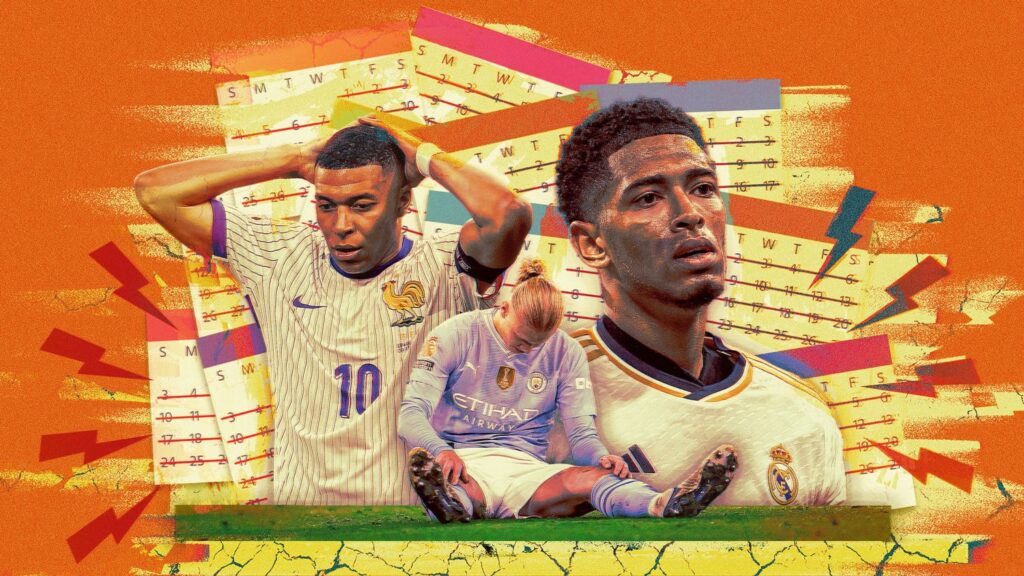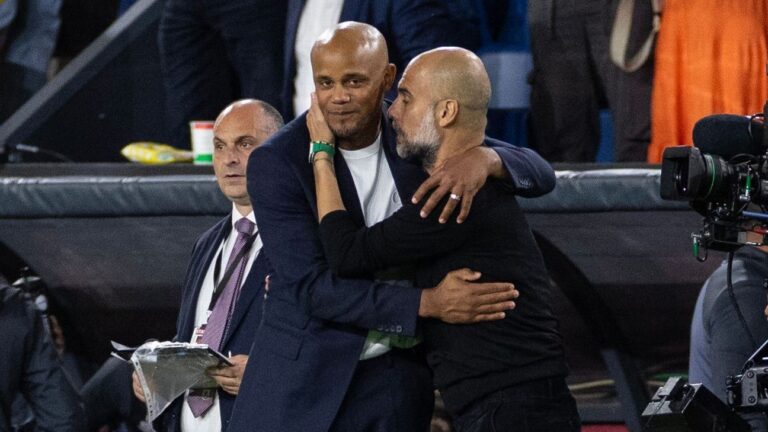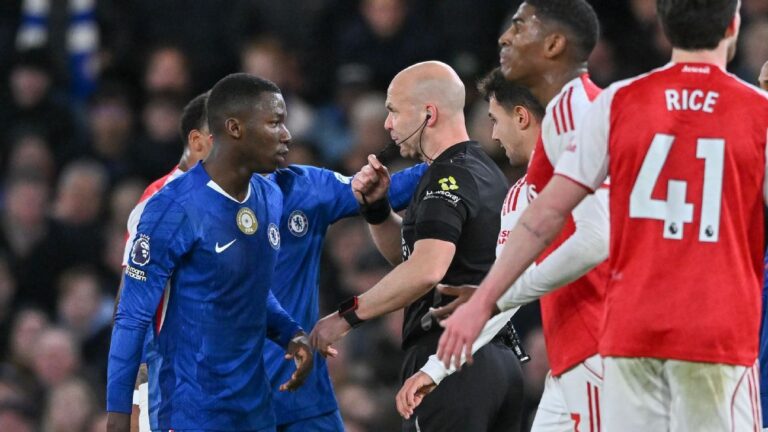Football is at a breaking point. If anyone doubts that, just ask Erling Haaland. Should all go to plan for the Manchester City forward during the 2024-25 campaign, his season will be 354 days long.
Ready or not, the new football season will be the longest and most physically demanding ever.
Haaland, Kylian Mbappé, Jude Bellingham — the game’s biggest stars — could each play over 70 games between now and the official end of the season, the FIFA Club World Cup final on July 13, 2025. Real Madrid’s Mbappé and Bellingham are yet to start their season — they’re on a delayed summer break because of their participation in Euro 2024 with France and England, respectively — but Haaland’s season is already underway, with the 24-year-old having played his first game in City’s friendly against Celtic in the United States on July 24.
And spare a thought for Haaland’s former City teammate, Julián Álvarez, as he prepares for life at Atletico Madrid. The Argentina forward played five games during his country’s Copa América triumph this summer, and then headed to France to represent the Albiceleste at the Paris Olympics. When he eventually enjoys a break — if he does — Álvarez might wonder when one season ended and the other began, and he won’t be alone. Football feels like it is beginning to eat itself with a pileup of games and added competitions, and the alarm bells are being sounded by players and coaches.
“I think we all saw in the Euros in general how tired people were,” Haaland said during City’s preseason tour of the U.S. this summer. “You could see the level, you could see even in people’s faces how tired they were of football, if you can say it that way.
“That’s how it will be as well this season, not in the start, though maybe for some because some will not get a lot of vacation. But that’s the way we’re going now. It’s difficult to be sharp if you play over 70 games a year.”
How has it come to this? How has football turned into a sport that is demanding more of its players, and supporters, than ever before? It is a sport of more games, more competition — and significantly less rest.
The FIFA Club World Cup, a 32-team tournament scheduled to run from June 15 (16 days after the Champions League final) to July 13 in the U.S. next year, is taking the club season into uncharted territory, occupying a space on the calendar usually reserved for international tournaments. In attempting to justify the new competition, FIFA sources told ESPN it is simply taking a slot once used for the Confederations Cup, a quadrennial eight-team international tournament, staged by the men’s World Cup host nation as a test event 12 months ahead of the main competition.
While the Club World Cup will add to the workload of the leading players at teams such as Man City, Chelsea, Real Madrid, Barcelona and Bayern Munich, this season’s debut of an expanded Champions League will also inflate the fixture list with eight group games rather than six. If City reach the final of every competition they enter — something Liverpool did during the 2021-22 season — manager Pep Guardiola’s team face a 75-game season, which started with the Community Shield against Manchester United on Aug. 10. That figure does not include preseason friendlies — which involved extensive travel and multiple time zone challenges in the U.S. — or the additional burden faced by international players who competed in tournaments this summer, before turning to World Cup qualifying over the next 12-18 months.
“It is getting to a tipping point,” Premier League chief executive Richard Masters told the European Leagues General Assembly in March. “The feedback we have from players is that there is too much football being played and there is constant expansion. If you pour more liquid into a cup that is already full, it will overflow. That is what is happening at the moment, not just in terms of the calendar, but in terms of the players’ ability to be able to perform at their best.
“It stands to reason if you overload the calendar and the players, at some point, something has to give.”
Last month, the European Leagues organization — a group of 26 professional leagues including the Premier League, LaLiga, Bundesliga and Serie A — announced it was filing a complaint against FIFA to the European Commission with players’ union FIFPRO Europe on competition law grounds amid concerns over the expanding football fixture list.
“Regretfully, FIFA has consistently refused to include national leagues and player unions in its decision-making process,” FIFPRO Europe and the European Leagues said in a statement. “FIFA decisions over the last years have repeatedly favoured its own competitions and commercial interests, neglected its responsibilities as a governing body, and harmed the economic interests of national leagues and the welfare of players.”
In response, FIFA accused the European Leagues of self-interest, saying, “Some leagues in Europe — themselves competition organisers and regulators — are acting with commercial self-interest, hypocrisy, and without consideration to everyone else in the world. Those leagues apparently prefer a calendar filled with friendlies and summer tours, often involving extensive global travel.”
While the game’s power brokers battle for control of the fixture calendar, the players must lace up their boots, take a deep breath and prepare for a season that will test their physical and psychological reserves like never before.
“This season is the season that will really put on the table all those issues,” Maheta Molango, the CEO of the Professional Footballers’ Association (PFA), told ESPN. “Because up until now, all of this could sound like something very distant.
“Everyone across football knows that the fixture calendar is broken to the point that it has now become unworkable.”
FIFA has been bracing itself for a fight with the major European leagues over its plans for the Club World Cup. Sources told ESPN that the existing calendar was approved by the FIFA Council, which includes FIFPRO and league bodies, although that calendar did not include the 2025 Club World Cup.
Club owners and senior executives have so far displayed little or no opposition to the plans, perhaps due to the prospect of prize money in the area of £80 million to £100 million being awarded to competing clubs, while FIFA posted a series of supportive comments in June from players likely to be involved in the 2025 Club World Cup.
Neymar, who now plays in the Saudi Arabia league for Al Hilal, said, “This is the place where Al Hilal and my teammates should be.” Flamengo’s David Luiz said, “If I have the opportunity to be at Flamengo and participate in this Club World Cup, [it] will definitely be one of the best championships I’ve ever played in my life.”
Seattle Sounders midfielder Cristian Roldan said, “To have a chance to compete at that level is something that we’ve always dreamed of,” while Auckland City midfielder Ryan De Vries said, “I think what FIFA is doing is unreal and it’s going to benefit a lot of teams.”
However, it’s a different story for those involved at the top level in Europe. While clubs across the globe will be relishing the profile and prestige of facing top teams like Real Madrid, the richest and most powerful domestic leagues are those in England, Spain, Germany and Italy and they feed into the biggest and most glamorous competition — the UEFA Champions League — and the players and coaches are under huge pressure to succeed. A player like Haaland might be rested for domestic cup competitions and perhaps a Champions League group game once City have qualified, but he would still be expected to perform in the vast majority of club fixtures.
A source close to Haaland told ESPN that the Norway international is “looking forward” to playing in the Club World Cup, but there is an awful lot of football to be played before that tournament begins. “There [are] more and more games, and it looks like it isn’t about to stop,” City midfielder Rodri said during Spain’s Euro 2024 campaign. “You have to take care of players. I’m very conscious of that. I reached a point where I can’t do it anymore.”
Manchester United suffered 45 separate injuries during the 2023-24 season, with premierinjuries.com reporting that the 21 players sidelined at one stage or another cost manager Erik ten Hag’s team 1,620 days lost to injury. United will not be involved in the FIFA Club World Cup, but they will play in the expanded UEFA Europa League and Ten Hag fears more problems in the months ahead. He is already without Rasmus Hojlund and new signing Leny Yoro with significant injuries suffered in preseason.
“The fixture list, the load on the players, is so high,” Ten Hag said. “The pressure is so immense and this season it’s getting even worse because of the new format in Europe. [Injury problems] will happen again.”
Chelsea coach Enzo Maresca told ESPN that the extended workload is a sign of the game’s increasing pursuit of financial rewards. “It is better for other people, for the business [to play more],” he said, before adding that “sometimes we need to think more about the players — it is a business, but probably we need to think more about the players.”
The strongest warning of the potential impact on players has come from none other than Guardiola. His City team will be expected to challenge for every competition they enter, and the breakdown of the fixtures they could face is daunting. He will be able to rotate his impressive squad, but commitments in the Community Shield (1 game), Premier League (38), Champions League (17), FA Cup (6), EFL Cup (6) and Club World Cup (7) amount to a possible 75-game season, which is why the former Barcelona and Bayern Munich coach has voiced his concerns.
“If the big bosses don’t think about the players then the managers have to think about them, otherwise they will die,” Guardiola said. “It’s too much. That’s why three weeks [summer break] is necessary, but the competition is there and you have to adapt.
“I said to [the players], ‘Come back when you have a desire to touch the ball. If you don’t feel it, don’t come back.’ We can’t demand much when they’re too exhausted to train properly. Before, we had five or six weeks to prepare for the first game but now it’s impossible. The first weeks will be tough, so go month-by-month, be there and see how far we get.”
The warning signs of player burnout were visible during Euro 2024. So many players failed to perform to their best, with Bellingham and Harry Kane both citing fatigue for their below-par performances for England. Bellingham said he was “mentally and physically exhausted” and blamed the “crazy schedule” for his problems while Kane spoke of a “really tough tournament, physically and mentally.”
For Darren Burgess, FIFPRO senior adviser on player workload, those comments, and the physical struggles of many other star names at Euro 2024, came as no surprise.
“There was a lot of teams that did seem like heavy-legged and it was just a tournament too far,” Burgess told ESPN. “Too many games, not enough rest.”
Putting that into perspective: Bellingham had registered 18,837 career minutes by his 21st birthday during Euro 2024, almost five times more than David Beckham (3,929 mins) at the same age. Real Madrid forwards Mbappé and Vinícius Júnior also represent the new era of footballers playing more than ever before.
“We [FIFPRO] have data that shows Mbappé, over a three-year period between August 2022 and July 2025, could play 198 matches,” Burgess said. “He’s done 56 and 58 games for club and country since August 2022 and we’re anticipating he could play 74 this season, plus up to 10 games with France in the Nations League and World Cup qualifiers. It’s just frightening with the expanded calendar next year.
“You can also look at the information we have on Vinicius Junior. By the age of 24, he had played 344 career games. If you compare him to Ronaldinho at the same age, he made 162, so that’s over double.”
A study commissioned by UEFA covering 54 teams in 20 European countries showed that as fixture lists became more congested, the occurrence of hamstring injuries grew from 12% of all injuries in 2001-02 to 24% by 2021-22. While the findings cannot prove causality, it is clear that muscle injuries are becoming more common as footballers are asked to play more games.
United boss Ten Hag made a similar point about injuries at the end of the club’s preseason tour when asked for his thoughts on the increase in games. “The fixture list, the load on the players is so high … The pressure on players is so immense and this season it’s getting even worse because of the new format in Europe.”
Mbappé, Vini Junior and Bellingham can at least console themselves with the knowledge that LaLiga clubs have a two-week winter break and only one domestic cup competition to enter. In England, two domestic cup competitions and no winter break add to the challenges facing the top Premier League players. Burgess, who had two-year stints with both Liverpool and Arsenal, says that the Premier League places unique demands on footballers.
“It’s on a different level,” Burgess said. “Physically, it’s a more demanding league and that’s objectively without question. I think there’s a balance to be made somewhere and there are really easy wins in things like midseason breaks that other leagues have, so you don’t actually have to have this issue.
“The NBA have gone down the path of trying to limit games in season from players, and restricting some games and minutes with veteran players along with a whole bunch of different rules which are really hard to police, but they’re trying to do it.
“When you’re in a single league you can probably do it a bit more effectively, but certainly the easy wins are extending these breaks so the players who play in European tournaments come and play matches within five weeks or whatever figure that you deem appropriate. The guys who come back from the Euros, the England players, will get their three weeks and most of them, within a day or two, they’re probably flying straight out to wherever the preseason tour is and playing in the first game.”
So where does it all end? Players and coaches are beginning to voice their fears more loudly and the major leagues and players’ unions are echoing their concerns.
There are historical precedents of strike action by players in the NBA and NFL, but footballers have yet to collectively walk out in protest over any previous issue. And while strike action within football still seems some way off, PFA CEO Molango told ESPN that it can’t be ruled out.
“Can we discount industrial action? Absolutely not,” Molango told ESPN. “Absolutely not, because it has come to a stage where it’s even the managers saying it. You just need to listen to what Guardiola has said, now and in the past, and you just need to listen to what [Mikel] Arteta has said and they’re all basically saying it has come to a stage where, if no one is looking after you, you need to look after yourself. That’s what may happen.
“We’ve always said that we’re open to try to find a solution and we think that we do have a solution and the solution is basically to let the science talk. That means a maximum number of games each season — between 50 and 60 — and a maximum of six back-to-back games (games played less than 72 hours apart). And finally, which is very important to us, a mandatory summer break of 3 to 4 weeks.
“You cannot finish on the 13th of July and be ready to play competitive games a month later. It doesn’t work like this. If you don’t protect the people who ultimately drive the industry, you’re going to end up having a problem.”
Football is ultimately big business. More competitions and ever-increasing broadcasting deals point to the demand from supporters and viewers, but surprisingly, FIFA has yet to secure a broadcast deal for the Club World Cup, despite it being less than 12 months away. Is there a market for it?
“It’s a pointless tournament, nothing more than glorified friendlies,” Dan Silver of the Chelsea Supporters’ Trust told ESPN. “It’s a tournament that is aimed at football tourists.”
“I’m surprisingly very excited about the Club World Cup,” Mike Tirone of the U.S.-based Footy Travelers told ESPN. “I can see the enthusiasm for the sport building in the United States as the popularity of European clubs grows rapidly and the country appreciates seeing the world’s best play in the comfort of their own country. And I absolutely plan to attend if tickets are reasonably priced.”
The Club World Cup is not the problem, but it may be the tipping point that forces football to find a solution. The sport is driven and funded by huge money across the globe, so perhaps it is the money that will ultimately talk loudest.
“My prediction is that all the stakeholders will finally see the sense in cooperating because that’s where the money is,” Chris Brady, chief intelligence officer for sports business advisers Sportsology, told ESPN. “If it doesn’t seem possible to kill off the opposition then it’s probably best to negotiate sharing the spoils.
“The theory of Coopetition [from Brandenburger and Nalebuff] whereby competing companies/organizations cooperate for the benefit of all parties, could well have been created with global sports businesses in mind. If we accept the burnout argument, there are not many alternatives in terms of what the outcome could be.”
In simple terms, that would mean FIFA, UEFA, the major leagues and the players’ unions settling their differences and coming together under one entity — a football version of the NBA or NFL, perhaps — and agreeing on a fixture calendar that suits everybody, but with memories still raw of the fan fury sparked by the aborted Super League plans in 2021, there is plenty of distance to travel before that would become a realistic outcome.
Unity and agreement among all parties appears unlikely at this stage, so the players will continue to play, registering more and more games each season, but at such a rate that football may have to adjust to a new normal of the greatest players shining brightly for a much shorter period of time.
“What we know is that if this keeps going on, it’s unsustainable to get peak performance every single game,” Burgess said. “And as consumers, that’s what we want: Our best players playing for as long as possible and as many games as possible. But that just won’t happen if continues at this rate.”
For players at the top end of the football pyramid, the fixture list continues to swell and the risk for players is high. It’s something Barcelona striker Robert Lewandowski summed up ahead of their preseason Clasico against Real Madrid. “We are, in the end, human. Of course we try to be the machine on the pitch, but we cannot forget that we are the human and also we need the time to rest properly. “




